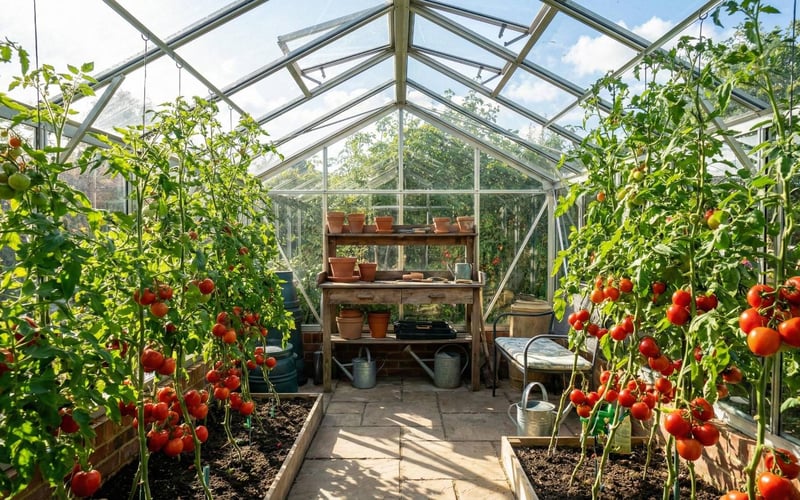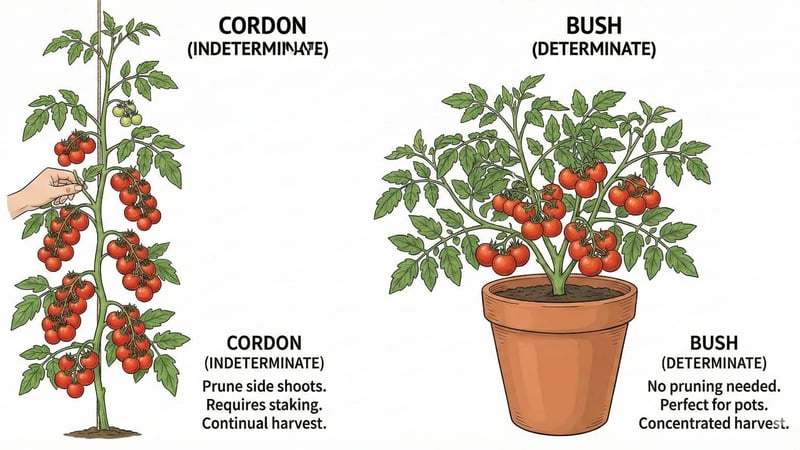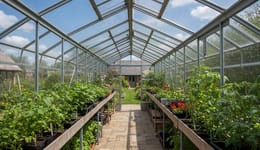Growing Tomatoes in a Greenhouse
Key Takeaways: Greenhouse Tomato Essentials
- ✅ Start Early: Sow seeds in February/March on a heated propagator or warm windowsill.
- ✅ The "Goldilocks" Zone: Aim for 21–24°C during the day and 15–18°C at night.
- ✅ Bigger is Better: Use pots at least 30-45cm wide to ensure healthy root systems.
- ✅ The "Tap" Trick: In a greenhouse, you must tap flowers daily to aid pollination (no wind inside!).
- ✅ Control Humidity: Keep humidity below 90% and use auto-vents to prevent mould and mildew.

Growing tomatoes is the number one reason many of our customers buy their first greenhouse. While you can grow them outdoors in the UK, growing tomatoes in a greenhouse transforms the experience from a battle against the elements into a controlled, high-yield hobby.
In our 16+ years helping UK gardeners, we have seen that the difference a glass barrier makes is huge. You get a harvest season that starts four weeks earlier and ends four weeks later than outdoor crops. Plus, you have a physical shield against the dreaded Late Blight that decimates outdoor plants in wet British summers.
Whether you have a spacious freestanding structure or a compact lean-to, this guide covers everything you need to know to go from seed packet to salad bowl.
Choosing Your Varieties: Cordon vs. Bush
Before you sow a single seed, you need to choose the right plant for your space. Tomatoes generally fall into two categories, and their pruning needs are very different.
Cordon (Indeterminate)
These are the most common greenhouse varieties. They grow tall as a single stem (up to 2m+) and require support.
- Yield: These produce the biggest crop per plant over a long season.
- Pruning: High maintenance. You must pinch out side shoots (the little shoots growing between the main stem and leaf branches) to concentrate energy on fruit. You should also remove lower leaves as the plant grows to improve air circulation.
- Popular Varieties: Gardener's Delight, Moneymaker, Sungold.
Bush (Determinate)
These stop growing at a certain height and form a bushier habit.
- Yield: While individual plants produce less than a cordon, determinate varieties can give you more fruit per square metre because they are compact and you can fit more of them in.
- Pruning: Low maintenance. No pinching out required.
- Popular Varieties: Tumbler, Red Alert, Tiny Tim.

The UK Growing Timeline
Getting your timing right is critical. Start too early without heat, and seedlings become "leggy" and weak. Start too late, and you miss the best sun.
General Rule: Start your seeds six weeks before the last frost date in your area.
| Month | Activity | Location |
|---|---|---|
| Feb - Mar | Sow seeds in trays/modules. | Heated propagator or warm windowsill (20°C). |
| April | Pot on into 10cm pots. | Greenhouse (if heated) or indoors. |
| Late April | Plant into final position. | Heated greenhouse only. |
| May | Plant into final position. | Unheated greenhouse (check for frost). |
| July - Oct | Harvest time. | Greenhouse. |
Pro Tip: Use staggered planting dates throughout the spring. Sowing a few seeds every two weeks ensures a continuous supply of tomatoes rather than a glut all at once.
For a detailed breakdown on timing, read our specific guide on when to plant tomatoes in an unheated greenhouse.
Getting Started: Sowing and Propagation
We recommend starting seeds in a propagator. Fill small pots or seed trays with high-quality seed compost. Sow seeds thinly and cover with a light dusting of vermiculite or compost.
Heat Mats: As mentioned in our original guide, heat mats placed under the plants can be a game-changer during the germination phase. They provide consistent bottom heat which speeds up root development significantly compared to a cold windowsill.
Once the seedlings have their first pair of "true" leaves, move them into 10cm individual pots on your greenhouse staging.
Planting Out and Support Strategies
Once the risk of frost has passed and the first flowers are appearing, plant your tomatoes into their final positions. Your choice of container and soil is vital for the long season ahead.
Containers & Compost
- Large Pots: We recommend pots that are at least 30-45cm wide and deep. This equates to roughly 15-20 litres of compost. Stick to one plant per pot. This volume ensures the roots have enough space to support a heavy crop.
- Grow Bags: A UK favourite. Pro Tip: While bags often suggest three plants, we recommend planting only two plants per bag. This reduces competition for water and nutrients.
- The Soil: Whether in pots or bags, use a high-quality peat-free, loam-based, or multi-purpose compost. Loam-based options (like John Innes No. 2 or 3) are excellent as they retain moisture better than standard multi-purpose compost.
Vertical Support
For cordon varieties, you need strong support.
- Canes: The traditional method. Push a bamboo cane into the soil next to the root ball.
- String Training: This is the professional greenhouse method. Tie a soft string loosely around the base of the plant and attach the other end to the roof glazing bars of your greenhouse. Twist the plant around the string as it grows.
The Perfect Environment: Temperature & Airflow
This is where many beginners struggle. A greenhouse is a fantastic heat trap, but you must manage the "micro-climate" to prevent disease and ensure pollination.
Temperature Targets
Tomatoes thrive in a specific range. Outside of this, growth slows or stops.
- Ideal Day Temp: Aim for 21–24°C (22-28°C max).
- Ideal Night Temp: Aim for 15–18°C.
- The Danger Zone: If temperatures hit 30°C, pollen becomes sterile, and flowers will drop without setting fruit.
Ventilation & Humidity
- Ventilation: You must open vents or doors to allow air circulation. Good airflow is essential to prevent diseases like mildew. We strongly recommend installing auto vent openers to manage this automatically.
- Humidity: Keep humidity below 90%. High humidity can cause issues like edema (blisters on leaves) and encourages mould.
- Fans: In a very still greenhouse, using a small solar or electric fan can help circulate air, strengthening the stems and preventing fungal spores from settling.
The "Greenhouse Tap"
Outdoors, the wind shakes the tomato flowers to release pollen. In a greenhouse, this doesn't happen naturally. To ensure a bumper crop, gently tap the flowering trusses (stems) every day around noon to shake the pollen loose.

Feeding and Watering: The Secret to Flavour
Consistency is the secret to perfect tomatoes.
Watering:
Water thoroughly after planting. Tomatoes hate erratic watering. If the soil dries out and is then flooded, the fruit will swell too fast and the skin will split. Maintain a regular schedule—some growers prefer letting the soil surface dry out slightly between waterings in the early weeks to encourage deep root growth, but consistency is key once fruit sets.
Feeding:
Start feeding with a commercial high-potash liquid feed (like Tomorite) or a homemade comfrey tea once the first truss of fruit has set (when you see tiny green tomatoes). Do not feed before this, or you will just get lots of leafy growth and no fruit.

Extending the Season: Winter Growing
One of the biggest benefits of a greenhouse is the "late shift." As autumn approaches and outdoor plants are killed by early frosts, your greenhouse tomatoes can keep going.
To get the most out of October and November, consider using greenhouse heaters. A simple paraffin heater or a thermostatically controlled electric fan heater can keep the night-time temperature within that crucial 15–18°C range, allowing the final trusses to ripen on the vine.
Lighting for Late Crops:
If you are planning for a fall or winter crop, natural light levels in the UK won't be enough. As noted in our original guide, you will need to supplement natural light with grow lights timed to operate 12-16 hours per day. High-pressure sodium (HPS) lights are a traditional choice for flowering/fruiting, though modern full-spectrum LEDs are now highly effective and energy-efficient.
Frequently Asked Questions
-
When should I start growing tomatoes in a greenhouse in the UK?
For a heated greenhouse, sow seeds in February. For an unheated greenhouse, sow in March. Planting out into the final position usually happens in May when night temperatures stay consistently above 10-12°C.
-
What is the best pot size for greenhouse tomatoes?
We recommend a pot that is at least 30-45cm wide and deep. This equates to roughly 15-20 litres of compost. Smaller pots dry out too quickly and restrict root growth, leading to smaller harvests.
-
How do I prevent mould and mildew on my tomatoes?
Keep humidity below 90% by opening vents and doors daily. Ensure good airflow (using a fan if necessary) and prune the lower leaves of the plant to improve air circulation around the base.
-
Why do greenhouse tomatoes split?
Splitting is caused by irregular watering. If a plant is left to dry out and then watered heavily, the fruit absorbs water faster than the skin can grow, causing it to burst. Maintain steady moisture levels to prevent this.
-
Do I need to hand pollinate tomatoes in a greenhouse?
Yes, it helps significantly. Tomatoes are self-fertile but need vibration to move pollen within the flower. Since there is no wind in a greenhouse, gently tapping the plant or shaking the trusses daily ensures fruit set.




